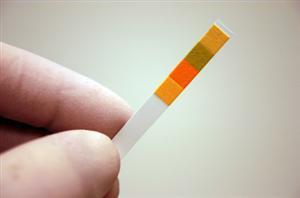| Complexity level: | 9 |
| Project cost ($): | 50 |
| Time required: | 2 hours to prepare, 10 hours for observation |
| Material availability: | Guppies and tanks can be purchased at a nearby store |
| Safety concerns: | None |
Hypothesis
The mortality rate of fresh water guppies (Poecilia reticulata) increases as the acid level in the water increases.
Overview
Acid rain
With increased industrial pollution, gases such as nitrogen oxide and sulfur dioxide are released into the atmosphere and are subsequently absorbed by droplets of water which form in clouds. Acid is formed when these gases are dissolved in the water droplets. This acidic water then returns to us in the form of rain or snow. The acid rain that descends onto our towns, roads, farms and forests then flow into our rivers and lakes through existing drainage systems.
Water in the rivers and fresh water lakes normally have a pH level falling between 6 and 8. However as a result of acid rain, pH levels in rivers and lakes drop as the water becomes more acidic. These acidic waters are a danger to the survival of a myriad of aquatic plants and animals that live in our rivers and lakes.
What is pH?
pH is the measurement of acidity and alkalinity. It ranges from 1 to 14.
- A neutral solution has a pH measurement of 7.
- An acidic solution has a pH measurement that falls between 1 to 6, with pH 1 being more acidic and pH 7 less acidic.
- An alkaline solution has a pH measurement that falls between 8 to 14, with pH 14 being more basic (alkaline) and pH 8 less basic.
- You should note that pH readings have decimals. Eg. pH 7.5.
Scientific Terms
Materials
The materials required for this experiment are as follows:
- 50 freshwater guppies (all fully grown)
- 5 fish tanks (not necessarily very large - as they are each required to hold only 1 liter of water)
- 6 liters of water
- 1 small bottle of vinegar
- 1 syringe (50-100ml)
- 1 small fishing net (to transfer the fish)
- litmus paper (you can purchase litmus strips at a drug store)
- 1 wooden spatula (large enough to mix the water in the tank)
- 1 clock (to record time)
Procedure
- For this experiment, the independent variable is the acidity or pH level of the water in the fish tanks. The dependent variable is the number of fish that remain alive in the tank over time. This is determined by counting the fish that are still alive every 2 hours. The constants (control variables) are the type of fish selected, the age of the fish (all fully grown), the solution used to make the water acidic and the amount of water in the tank, the water used for each tank, and water temperature and lighting conditions.
- The 5 fish tanks are washed and cleaned. Do not use soap to wash the tank. 1 liter of water is poured into each of the tanks.
- The syringe is used to add vinegar into the 1st tank. After adding a little vinegar a wooden spatula is used to mix the water in the tank. The litmus strips are used to measure the acidity of the water in the tank. More vinegar or water is added to the tank until the pH level reaches 6.5.
- Procedure 3 is repeated until the pH level of the water in tank no. 2 is 6.0, tank no. 3 is 5.5, tank no 4 is 5.0 and tank no. 5 is 4.5.
- Each of the tanks is filled with 10 guppies and the clock is started. The number of guppies still surviving is monitored and recorded every 2 hours for 10 hours and the readings are recorded in the table given below.

Results

The guppies in the more acidic water will die faster and the guppies in the least acidic water will live longer.
Use the below graph to plot the results of above observation.

Conclusion
The hypothesis that the mortality rate of fresh water guppiesincreases as the acid level in the water increases, is proven to be true. Acid is toxic to the guppies and as the level of acidity of the water increases, the guppies are poisoned and die.
The problem of acid rain and pollution is very serious.
Some aquatic animals may have higher tolerance for acidic water whereas others may die and become extinct. The increase in acidity can also affect the growth and development of the species. Some of the species may not be able to hatch the eggs in acidic water. All of these will have a serious impact on the food chain and biodiversity of the ecosystem.
Also consider
The experiment can also be performed using aquatic plants to substitute the fish.
You might want to consider using different species of freshwater fish for the experiment, to ascertain if different species have a different level of tolerance for acidic water.
Vinegar can be replaced by soap detergent to see if it also has a toxic effect on fish.
References
- http://www.epa.gov/acidrain/effects/surface_water.thml
- http://www.answers.com/topic/ph

